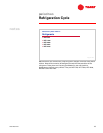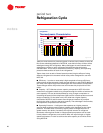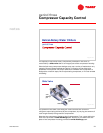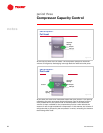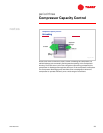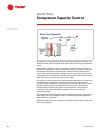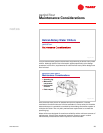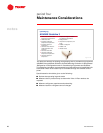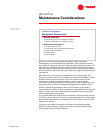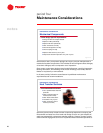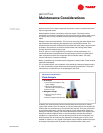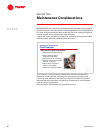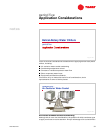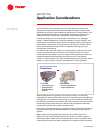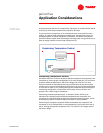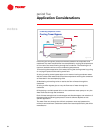
TRG-TRC012-EN 27
period four
Maintenance Considerations
notes
Direct-drive, semi-hermetic compressor designs require no periodic
maintenance on the compressor/motor assembly. The compressor contains
only 3 main moving parts: the male and female rotors and the slide valve. The
semi-hermetic motor eliminates the need for external shaft seals associated
with open motors. These seals are a prime source of oil and refrigerant leaks. It
also eliminates annual coupling and seal inspections, alignment, and shaft seal
replacement.
With the advent of microprocessor-based controls, the control panel and
auxiliary controllers require no recalibration or maintenance. Remote-mounted
electronic sensors send information to the unit controller, which can be
connected to a building automation system in order to communicate
information and allow for system-level optimization. These systems can notify
the operator with an alarm or diagnostic message when a problem occurs.
Like any mechanical equipment, a daily visual inspection of the chiller is
recommended to look for oil leaks, condensation, loosened electrical or control
wiring, or signs of corrosion. Special attention should be given to the safety
controls and electrical components.
It is recommended that a qualified service technician check the chiller annually
for leaks. In the normal service of any air conditioning system, the Unites States
EPA mandates that whenever a refrigeration circuit is opened, recovery of the
refrigerant is required.
Finally, the vent piping of all pressure relief valves should be leak-tested
annually for the presence of refrigerant to detect improperly sealed valves.
Leaking relief valves should be replaced.
▲ Required maintenance
◆ Compressor and motor: no maintenance required
◆ Controls: no maintenance or calibration required
▲ Recommended maintenance
◆ Visually inspect overall unit
◆ Inspect safety controls and electrical components
◆ Tighten electrical connections
◆ Check for leaks
◆ Test vent piping
maintenance considerations
Mechanical Components
Figure 40



